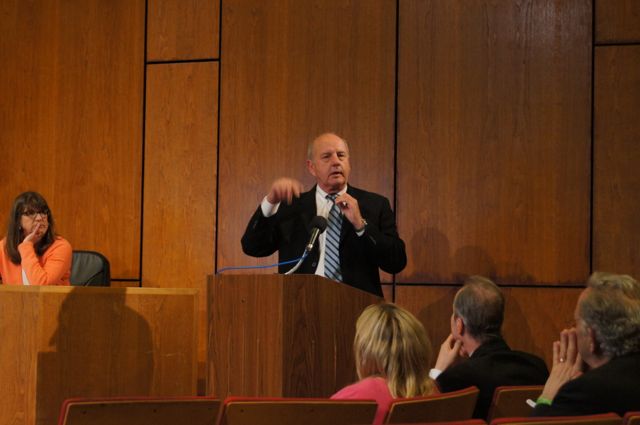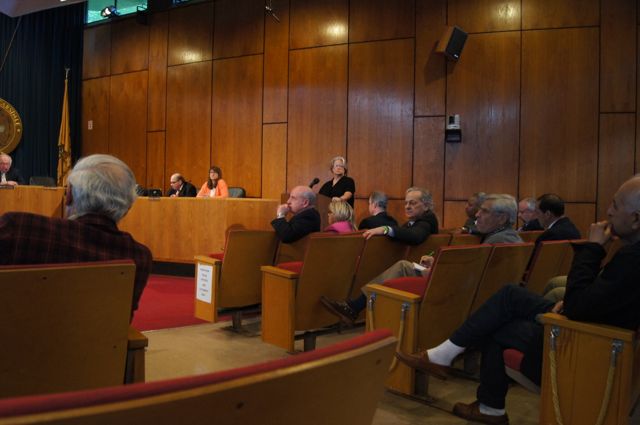Tyler Defends Revaluation Methodology in Scarsdale
- Tuesday, 03 June 2014 21:44
- Last Updated: Thursday, 05 June 2014 13:45
- Published: Tuesday, 03 June 2014 21:44
- Joanne Wallenstein
- Hits: 7649
 A large crowd turned out on Thursday May 29 to hear answers from Tyler Technologies on the methodology behind the first revaluation of Scarsdale real estate in 43 years. Many who rarely visit Village Hall appeared to have come to listen as well as to vent about the results of the revaluation that caused dramatic changes to some property assessments.
A large crowd turned out on Thursday May 29 to hear answers from Tyler Technologies on the methodology behind the first revaluation of Scarsdale real estate in 43 years. Many who rarely visit Village Hall appeared to have come to listen as well as to vent about the results of the revaluation that caused dramatic changes to some property assessments.
In an effort to keep the crowd under control, Mayor Bob Steves gave the floor to Tyler for a lengthy presentation and initially asked those with questions to submit them on index cards rather than come to the podium themselves. He warned the audience that this was not the opportunity to debate the valuation of individual properties but a time to learn more about how properties were assessed.
Eugenia Flynn, the Appraisal Operations Manager at Tyler, shared her credentials and introduced the Tyler team that includes Dr. Richard A. Borst, a senior research scientist – and statistician. Also on hand was John Ryan, an independent revaluation consultant who was hired by Scarsdale Village to monitor the process. Ryan told the group, "If you have good data in the system they are the basis of good values." John Wolham of the NYS Office of Real Property Tax Services also attended the meeting. He will certify the new tax roll when the process is complete.
Flynn explained that the purpose of the revaluation was to bring appraisals to fair market value. The process was begun in 2012 and considers property class, location, desirability and market supply and demand using fair market value as of July 1, 2013.
She explained the difference between a mass appraisal where "all properties are appraised using a common database, uniform methodology and allows for statistical testing of the results," versus individual appraisals who are done by a real estate agent, a certified appraiser or a bank.
According to Flynn, "Equitable appraisals among similarly-valued properties is critical. The same model is  applied to all properties." In Scarsdale, "95% of homes were inspected (a highly unusual access rate), Tyler built and tested models and valued all properties using these models." Since, "land directly relates to the desirability of a property's specific location." Tyler "analyzed all vacant and teardown land sales to develop land valuation models that were considered to reflect the market as of July 1, 2013." Scarsdale was divided into 13 areas for the purpose of defining comparable sales.
applied to all properties." In Scarsdale, "95% of homes were inspected (a highly unusual access rate), Tyler built and tested models and valued all properties using these models." Since, "land directly relates to the desirability of a property's specific location." Tyler "analyzed all vacant and teardown land sales to develop land valuation models that were considered to reflect the market as of July 1, 2013." Scarsdale was divided into 13 areas for the purpose of defining comparable sales.
Following the completion of the process earlier this year, notices of the new property assessments were mailed to residents and posted online. Property owners were given the opportunity to have informal meetings with Tyler, and 927 or 15.6% of property owners met with Tyler and 1,088 properties were reviewed. This week, June 1, revised mailers were sent out to those who asked for a review, and the valuations of approximately 437 properties were changed.
Property owners who wish to grieve their new assessments can do so between June 2 – 17, and the final assessment roll for 2015 will be filed by the Village in September, 2014. The Tyler powerpoint presentation has been posted on the Village website and can be viewed here:
A question was asked about how assessments will be updated in the future and Village Assessor Nanette Albanese explained that now that the Village has done the revaluation they have the right to review assessments on an ongoing basis and make changes if they spot trends that affect a group of properties. The Village has submitted a grant application to the state for funds for personnel to keep the property tax roll updated. From the discussion it was not 100% clear how this would be accomplished but Village officials agreed that the roll would be maintained and they would not let many years lapse without a reassessment.
Many questions were asked about the value of the land vs. the home, the inclusion and weight of different variables in the model, the process for making corrections for over-assessed and under assessed properties and the difference between land values in each of the 13 assessment areas.
The statistician spoke at length about the statistical modeling process, but it was very difficult to understand his explanation.
At one point, someone in the audience asked Tyler if they have a way to do the revaluation in a more transparent manner. Borst responded that it is possible to put constraints into the mathematical process that would do this.
The meeting went on after 11 pm with the Mayor giving everyone a chance to speak – some even twice. Despite the call from the Heathcote Association to delay the revaluation, Mayor Steves indicated that " we will make what we have here work," and said he saw little benefit to repeating the process. In addition, Wolham and Borst of Tyler agreed that the model was valid and fell within a 97-98% tolerance level, even if it did not pass muster with some of the taxpayers.
The session was recorded and can be viewed online here:














